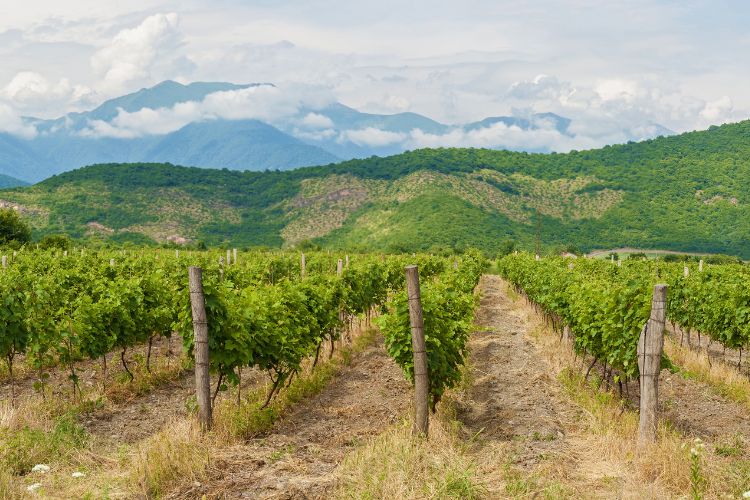Travel to the Cradle of Wine – The Republic of Georgia
While wine has carved its niche in the annals of global history and is an integral component of numerous cultures worldwide, its roots are deeply embedded in one specific locale: the Republic of Georgia. This nation doesn’t just share a bond with wine; it is revered as its birthplace. Archaeological discoveries have consistently identified the South Caucasus region of Georgia as the site of the earliest known wine production, a practice dating back to 6,000 BC.
This means Georgia’s winemaking heritage spans over 8,000 years, distinguished by its traditional Qvevri winemaking method, a technique so unique that it has earned the accolade of a UNESCO Intangible Cultural Heritage. Yet, beyond the accolades and history, it’s the tangible elements—the hospitable people, the rich culinary landscape, and the distinctively Georgian wines—that truly make a journey to the Republic of Georgia an enriching and memorable experience.
In This Guide
- Wines of Georgia
- Georgian Cuisine
- Getting To and Around Georgian Wine Country
- Tbilisi
- Kakheti Wine Region
- Recommended Georgian Wine Tours & Guides
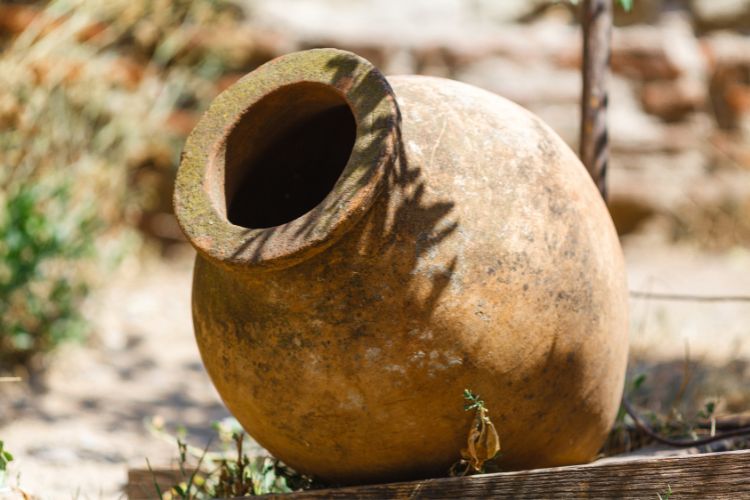
Georgian Wine Production
Georgia’s winemaking heritage is deeply rooted in its four primary wine-producing regions: Kakheti, Imereti, Kartli, and Racha. The country includes 29 Protected Designations of Origin (PDOs) and a rich diversity of indigenous grape varieties, numbering over 525, with 45 of these varieties actively cultivated in commercial viticulture. Among these, approximately 75% are white grape varieties, and 25% are black (red) grape varieties.
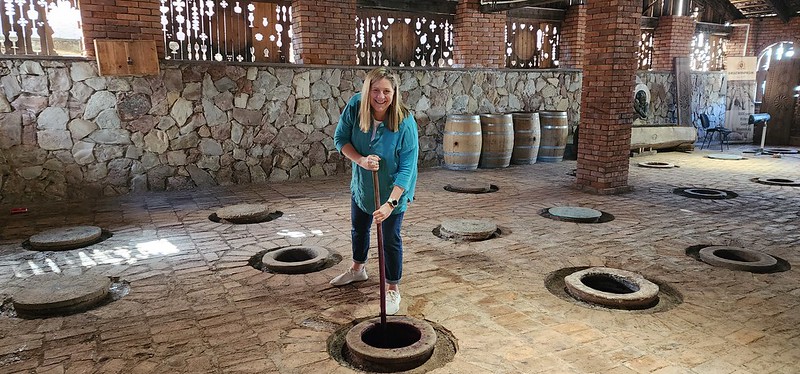

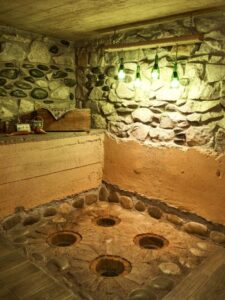
Old Georgian wine cellars where Qvevri are stored showcase the unique and historic method of winemaking deeply rooted in Georgian culture. Images courtesy Allison Levine and Andrey Khrobostov.
While modern methods like stainless steel and oak aging are employed, Georgia is renowned for its traditional use of Qvevri, large clay vessels, for wine fermentation and aging. A unique aspect of Georgian wine production involves the method of fermenting white grapes in Qvevri along with their seeds, skins, and occasionally stems. This process imparts an amber hue to the wine, often referred to as ‘amber wine’ or ‘orange wine’ due to its distinct color and rich, tannic profile. These amber wines, celebrated for their depth of flavor and historical significance, are a source of immense pride in Georgian viticulture.
Amber or orange wines are essentially white wines made using a method more akin to red wine production, where the grape skins are left in contact with the juice for an extended period, resulting in a wine with a deep amber or orange hue, a fuller body, and a unique flavor profile that distinguishes it from traditional white wines. You can learn more about orange wine production here.
The #WinesofGeorgia
Here are some of the main Georgian wines and the grape varieties involved in their production:
Saperavi: This is arguably the most famous red wine from Georgia. Made from the Saperavi grape, which is a teinturier variety (both skin and flesh are red), it produces deeply colored, full-bodied wines with bold flavors and high tannin content.
Rkatsiteli: One of the oldest grape varieties, Rkatsiteli produces a highly acidic and versatile white wine. This wine can range from crisp and light to rich and full-bodied, depending on the production method, including the traditional Qvevri method.
Mtsvane Kakhuri: Often simply known as Mtsvane, this grape produces elegant and aromatic white wines. These wines typically have floral and fruity notes, with a balanced acidity that makes them quite refreshing.
Tsinandali: This is a dry white wine blend, primarily made from Rkatsiteli and Mtsvane grapes. Tsinandali is known for its straw color, fruity aroma, and a well-balanced, sophisticated flavor profile.
Kindzmarauli: A semi-sweet red wine primarily made from the Saperavi grape. Kindzmarauli stands out for its natural sweetness balanced with acidity, deep purple color, and fruity notes.
Khvanchkara: Another popular semi-sweet red wine, Khvanchkara is a blend of the Alexandrouli and Mujuretuli grape varieties. It is known for its ruby color, floral aroma, and raspberry notes.
Georgian Food
Georgian cuisine, a vibrant blend of flavors and techniques, has evolved over the centuries under the influence of various cultures, including Mediterranean, Greek, Persian, and Turkish culinary traditions. Each region within Georgia has its own unique culinary style and preparation methods, reflecting the diverse landscape and cultural influences of the country.
Agriculturally rich, Georgia has traditionally placed a strong emphasis on vegetarian dishes, with meat historically being a luxury reserved for special occasions. In contemporary Georgian cuisine, however, there is a more balanced incorporation of meats alongside staple ingredients like breads, cheeses, walnuts, and fresh tomatoes. Notably, walnuts, a key ingredient found in many Georgian recipes, highlight the country’s status as a significant walnut producer. The cuisine’s diversity and the use of fresh, locally sourced ingredients like walnuts, are central to its appeal and uniqueness.

Some popular Georgian dishes include:
Khachapuri – This beloved Georgian staple is essentially a cheese-filled bread, but it’s much more than that. Each region has its own variation, ranging from a simple cheese-topped bread to elaborate versions with added ingredients like egg and butter.
Puri – This is a type of Georgian bread, traditionally baked in a toné, a deep, circular clay oven. The bread has a unique texture and flavor, partly due to the distinctive baking method, which imparts a smoky, earthy aroma.
Pkhali – Often served as an appetizer, Pkhali is a kind of vegetable pâté, combining finely chopped and cooked vegetables (like spinach or beets) with a rich walnut paste, seasoned with garlic, herbs, and spices. It’s a colorful and flavorful showcase of Georgia’s love for walnuts.
Badrijani Nigvzit – This dish features tender strips of roasted eggplant (badrijan) wrapped around a savory, spiced walnut paste. It’s a delightful combination of textures and flavors, balancing the softness of the eggplant with the richness of the nuts.
Ajapsandali – A hearty and spicy Georgian eggplant stew, Ajapsandali is a medley of vegetables including eggplants, tomatoes, bell peppers, and onions, often seasoned with fragrant herbs. It’s a vibrant and nourishing dish, perfect for those who love robust flavors.
Khinkali – These are Georgian dumplings, notable for their twisted, knob-like shape. Typically filled with meat, cheese, or mushrooms, and a hot broth, Khinkali are a culinary delight, served boiled or steamed. They are a true test of one’s eating skills; the trick is to consume them without spilling the savory broth inside.
Churchkhela – Often referred to as Georgian candy, Churchkhela is a traditional sweet made by stringing walnuts together and dipping them in thickened grape must mixed with flour. This results in a candle-shaped treat that’s chewy, nutty, and satisfyingly sweet, often found hanging in markets and roadside stalls.
How To Get To Georgia
The Republic of Georgia is located at the juncture of Eastern Europe and Western Asia. Part of the Caucasus region, it is bordered by the Black Sea to the west, Russia to the north and northeast, Turkey to the southwest, Armenia to the south, and Azerbaijan to the southeast. A stop on the Silk Road, Georgia has been a convergence of civilizations over the centuries until becoming part of the Soviet Union. It gained its independence in 1991 but spent the next decade dealing with political and social unrest. Fortunately, since 2008, Georgia has rapidly expanded for tourism and today is one of the safest countries in Europe.
To get to Georgia, the best airport to fly into is in Tbilisi, the capital city of Georgia. If you want to travel around Georgia into the wine regions, it is very safe to travel on your own by renting a car (you can browse current flight and rental car rates here on Kayak). However, for travelers in Georgia, private transportation often proves to be the most convenient option. This is partly because the Georgian language, which has its own unique alphabet, is predominantly spoken throughout the country. While many locals are fluent in Russian, a legacy of Georgia’s historical ties with Russia, English is less commonly spoken, especially outside of Tbilisi and key tourist areas. However, visitors will find that the warmth and hospitality of the Georgian people often bridge the language barrier effectively. Assistance from a guide can further enhance the travel experience, ensuring smooth communication and a deeper understanding of the local culture and places.
You can book one of our favorite private wine tour guides and a full day guided trip right here.
Tbilisi
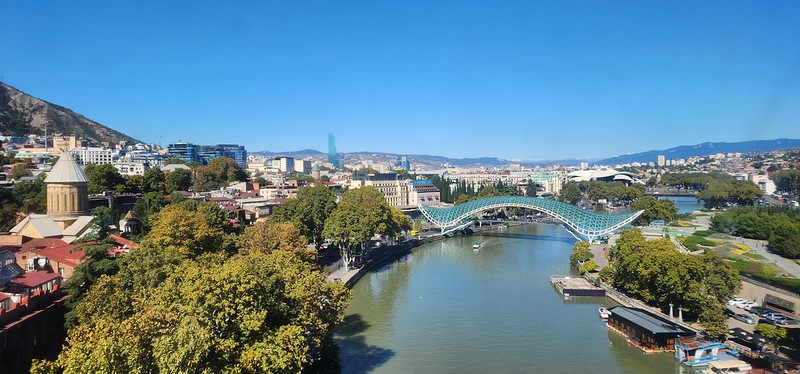
Tbilisi, as Georgia’s capital and its largest city, holds significant historical and cultural importance. The city is divided by the Kura River, known in Georgia as the Mtkvari River, which originates in Turkey and flows to the Caspian Sea. Central to Tbilisi’s charm is the historic Old Tbilisi area, dating back to the Middle Ages, which forms the core of the city. Additionally, parts of the city reflect 18th-century Georgian architecture.
Since gaining independence, Tbilisi has seen the development of modern architectural structures. This includes key government buildings like the President’s House and the Public House, as well as cultural venues like the Concert Hall, all located along the river’s edge. The Bridge of Peace, a contemporary pedestrian bridge made of steel and glass, spans the Mtkvari River and links the historic Old Town with newer parts of the city.
What to Do in Tbilisi
Exploring Tbilisi
Most of Tbilisi’s notable attractions are concentrated in Old Tbilisi, making it an ideal area for a walking tour, whether self-guided or with a guide. The tour can start at Freedom Square, a central and historically significant location in the city. This square, once known as Lenin Square during the Soviet era, now features a striking golden statue of St. George slaying a dragon, symbolizing the nation’s transformation.
As you stroll through the cobblestone streets of Old Tbilisi, you’ll notice a diverse mixture of architectural styles, with many houses charmingly covered in vines. The neighborhood highlights Tbilisi’s historical role as a significant hub on the Silk Road, evident in the close proximity of religious and cultural sites representing various faiths and communities. These include Armenian, Georgian Orthodox, Jewish, and Catholic places of worship, reflecting the city’s rich multicultural heritage influenced by the myriad of traders and travelers who passed through over centuries.
Two exceptional ways to see the city are from the water and from up high. By boat, sail down the Kura River and under the Bridge of Peace for a unique perspective of Tbilisi. Pass by cliffs, the 13th-century Metekhi church, the Royal Baths, and Rike Park. There are many boat companies by the river offering 30-minute boat tours day and night.
For an aerial view, take the Aerial Tramway located beside Rike Park. The tram can be taken during day or night. It travels from one side of the river to the other, with the Bridge of Peace always in view. From the top, in addition to breathtaking views, you can visit the Narikala Fortress as well as the Botanical Garden. Locally guided tours including the cable car can be arranged ahead of time.
Starting from the summit reached by the tram, descend the hill to reach the Leghvtakhevi Gorge, home to a notable waterfall. This natural feature is integral to Tbilisi’s history, being the source of the city’s famed sulfur waters. Tbilisi’s very name originates from the local word for “warm place,” a nod to these therapeutic waters. In the Abanotubani neighborhood of Old Tbilisi, you’ll find a concentration of sulfur bathhouses. Drawing inspiration from Persian and Turkish bath traditions, these bathhouses offer a serene escape, inviting #Winetravelers to unwind in the warm, healing embrace of the sulfuric waters.
Wine in Tbilisi


A glimpse of what you can expect at the Tbilisi Wine Museum. Images courtesy Allison Levine.
To learn about the 8000-year history of Georgian winemaking, visit the Tbilisi Wine Museum (8 Sioni St, Tbilisi, Georgia) housed in a 17th-century building that sits over a preserved underground city. The museum is below the MtKvari River and includes artifacts that have been discovered during archaeological excavations.
When ready to enjoy Georgian wine, head to Vino Underground near Freedom Square (15 Galaktion Tabidze St, Tbilisi, Georgia). Opened in 2011, it was the first wine bar and retail store for natural wine in Georgia. Owned by six of Georgia’s most well-known natural wine producers, including American-born John Wurdeman, Vino Underground is in a small, brick-lined cellar. Featuring small-production, family-owned wines, there are more than 200 options to try. Enjoy a glass at the bar or take a few bottles home.
Fun Find
Next door to Vino Underground is the Bitadze Tea Shop & Museum, a tiny museum founded by father and son Shota and George Bitadze.
Tea was introduced to Georgia in the early 19th century. The first instance of tea cultivation in Georgia dates back to 1809 when Prince Mamia V Gurieli began growing Camellia Sinensis, the tea plant, in his botanical garden. However, it was in 1847 that Prince Miha Eristavi established the first tea plantation in Georgia after smuggling tea seeds from China. This event is often marked as the birth year of Georgian tea and the beginning of tea culture in the region.
The first tea bushes in Georgia were planted in 1845 in western Georgia, but significant development in the tea industry began towards the end of the 19th century under the Russian Empire, which showed interest in cultivating the tea industry in Georgia. This period saw the engagement of experts to develop tea plantations in the country. The first tea factory in Georgia was open from 1893 to 1925 and was run by a Chinese tea master. During Soviet rule, tea was manufactured but production was abandoned after the Soviet collapse.
In 2006, the Georgian Organic Tea Producers Association was created. It began with educating producers about new technology and now they send farmers to study in tea-producing countries such as China. Stop by the Bitadze Tea Museum before or after a stop at Underground Vino to purchase some Georgian black, green, and herbal teas. In addition to selling Georgian tea, they offer a tea-tasting experience and can also arrange visits to tea plantations in Georgia.
Where to Eat in Tbilisi
Satasuri
Ninoshvili st. 2, Tbilisi 0102 Georgia
Satasuri, which means asparagus in Georgian, is owned by Ekaterine and Iva Davitaia. The restaurant is located next to Fabrika Tbilisi, a cool, industrial-style factory-turned-hostel offering a bar and an eclectic lounge. Satasuri was originally the home of Ekaterine’s parents. She and Iva come from the hospitality industry and opened Satasuri in 2020, opting to feature Georgian flavors with modern innovation. In addition, they have a selection of wines from small producers. Interestingly, all wines are sold for the exact same price, giving Iva a chance to introduce people to interesting wines.
Cafe Leila
18 Ioane Shavteli St, Tbilisi, Georgia
Café Leila is a charming vegetarian café in Old Tbilisi. The building was first built as an art gallery and then became a Middle Eastern sweet shop. The interior has still been preserved since Soviet times. In addition to authentic Georgian vegetarian dishes, they also serve fish dishes in a charming and cozy setting.
Azarpesha
0105, 2 Pavle Ingorokva St, Tbilisi, Georgia
Azarpesha is a wine-centric restaurant located near Freedom Square. It’s owned by a local collector, folklorist, and cultural preservationist. The restaurant offers a modern Eastern-Mediterranean menu inspired by food cultures Georgia traditionally traded with, including Persia and Byzantine Greece.
Where to Stay in Tbilisi
Sheraton Grand Tbilisi Metechi Palace
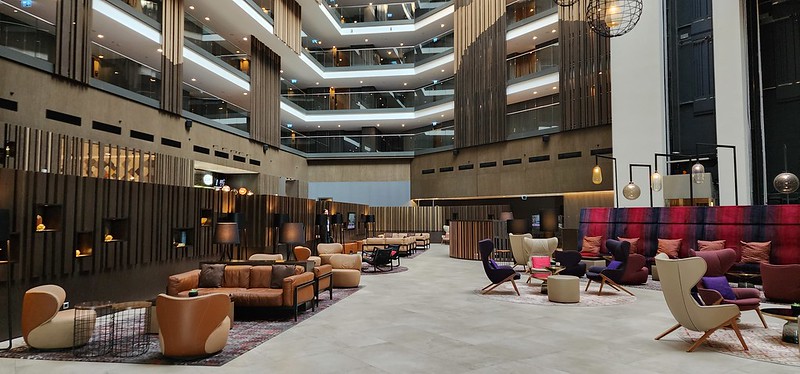
Located a 10-minute drive outside of Old Tbilisi, the Sheraton Grand Tbilisi Metechi Palace is the first international 5-star hotel in Georgia, offering 220 rooms and views of Old Tbilisi.
Check Prices at the Sheraton Grand Tbilisi on Tripadvisor
Bazaar Boutique Hotel
Located in the historic neighborhood of Tbilisi, Bazaar Boutique Hotel celebrates design with its bold presence and individualized guest rooms.
Check Prices at the Bazaar Boutique Hotel on Tripadvisor
Stamba Hotel
Located in the Mtatsminda District of Tbilisi, Stamba is a creative hub. In addition to the urban luxury rooms, Stamba has a café, workspace, amphitheater, photography museum, and library. The hotel is also developing the first urban vertical farming project in the region.
Check Prices at the Stamba Hotel on Tripadvisor
Rooms Hotel
Rooms Hotel is in a former publishing house in the Vera district of Tbilisi. The 122-room hotel is industrial-chic and includes wine bars, boutiques, and an outdoor yard.
Check Prices at ROOMS Tbilisi on Tripadvisor
Kakheti Wine Region
One hour away from Tbilisi is the Kakheti wine region, the most famous wine region in Georgia. It consists of eight districts: Gurjaani, Qvarelli, Sagarejo, Dedoplistsqaro, Signangi, Lagodekhi, Akhmeta, and Telavi, its capital. Wine is likewise very important in Kakheti and symbols of the beverage can be found everywhere. Grapes are carved into old stone structures and Qvevri are found in the fountains throughout the squares and villages of the region.
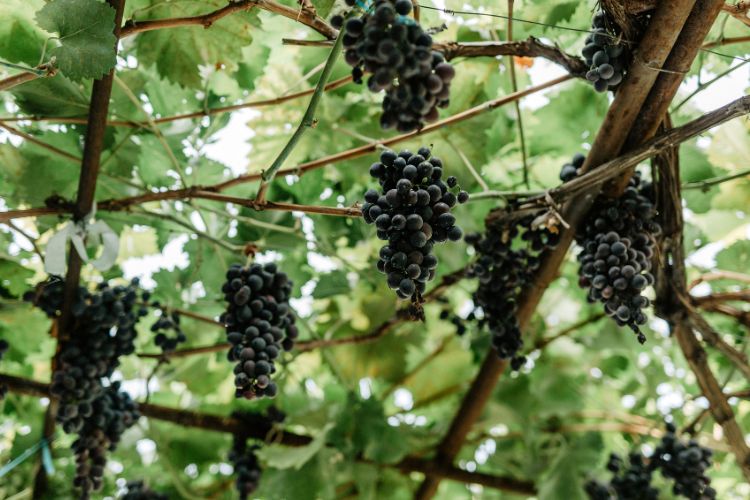
Of the 48,000 hectares of vineyards in Georgia, 33,000 hectares are located in Kakheti. 80% of the vineyards in Georgia are in Kakheti and 20 of the 29 PDOs are also found in this region. The principal white grapes in Kakheti are Rkatsiteli, Mtsvana Kakhuri, Kisi, and Khikhvi. The primary red grape is Saperavi. Kakheti has a continental climate with rich diverse soils called “cinnamomic” as they consist of sandy, reddish, calcareous clays. The grapes are all hand-picked and there is no irrigation.
Sighnaghi
Sighnaghi, perched atop a hill, offers an eye-opening panoramic view of the Alazani Valley with the majestic Caucasus mountains in the backdrop. The town’s name, derived from the Turkish “signak” meaning shelter, reflects its historical role as a bastion against invasions, established in the 18th century. Encircling the town is an impressive four-kilometer fortress wall, complete with towers and gates, cascading down the hills, reminiscent of a miniature Great Wall of China. This wall is not just a historical relic; visitors can actually walk along it.
Often celebrated as Georgia’s city of love, Sighnaghi charms with its well-preserved cobblestone streets and architecture dating back to the 17th and 18th centuries. Dotting these streets are notable establishments like Pheasant’s Tears and Orko’s Wines.
Pheasant’s Tears, set in a building that’s over 300 years old, enjoys a reputation as one of Georgia’s finest dining establishments. It was opened by John Wurdeman, an American artist who discovered Georgia during his art studies in Moscow. Wurdeman has played a pivotal role in both preserving and revitalizing Georgia’s ancient winemaking traditions. His organic, unfiltered wines, fermented and aged in Qvevri, have garnered international attention. The restaurant, helmed by chef Gia Rokashvili, offers a unique dining experience with no fixed menu; instead, Rokashvili crafts daily culinary creations using fresh, local market produce.
Adjacent to this culinary gem is Okro’s Wine Restaurant & Cellar, established by native Sighnaghi resident John Okruashvili. Naming his venture after the Georgian word for gold, “Orko,” Okruashvili released his first wine in 2009. Specializing in traditional, organic Qvevri wines, he utilizes grapes from his own vineyard. The winery’s restaurant features a terrace that provides splendid views of the Alazani Valley, making it a perfect spot to savor these unique wines.
Where to Stay in Sighnaghi
Lost Ridge Inn is a boutique inn, a restaurant, a craft brewery, and a horse ranch all in one. It is located on a crest overlooking the Alazani Valley and the Caucasus Mountains. This rural getaway is the first of its kind in Georgia and is also owned by John Wurdeman. The boutique hotel has six rooms, each with a modern rustic vibe. The Lost Ridge Café serves a seasonal menu with ingredients from their permaculture garden. The craft brewery produces beer onsite and ages it in the onsite beer cave. And they offer horseback riding in the mountains.
Check Prices at Lost Ridge Inn in Sighnaghi on Tripadvisor


Horseback riding and craft beer tasting at Lost Ridge Inn. Images courtesy Allison Levine.
Gurjaani
The Gurjaani Municipality, less than an hour north of Sighnaghi, is in the heart of the Kakheti region and is home to more than 80 wineries. Nine of the PDOS in Georgia come from the Gurjaani region. This is where the annual Gurjaani Wine Festival, a celebration of the heritage and diversity of Georgian wine, takes place each October.
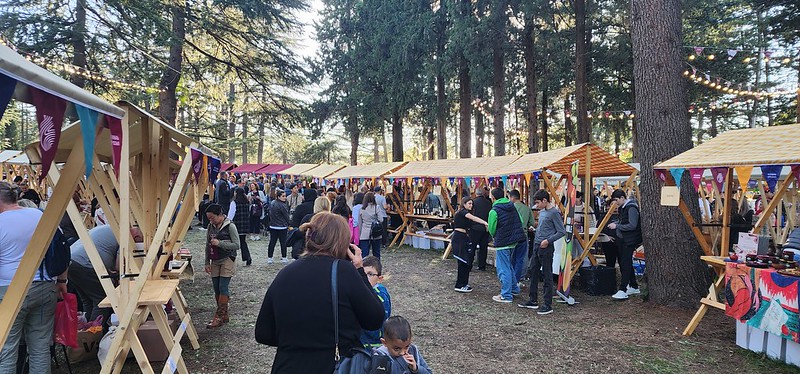
More than 30,000 people attend this event which takes place in the forested Akhtala Park and features hundreds of wineries of all sizes, handicraft vendors, live music, cultural exhibitions, and local Georgian foods, including Kakheti barbecue. This festival is a great reason to travel to Georgia in October.
Where to Stay in Gurjaani
Located in the Gurjaani region’s village of Vazisubani, the Vazisubani Estate is a blend of historical elegance and contemporary luxury. Established in 1891, this graceful estate and vineyard was initially the property of a Georgian nobleman, before transitioning to state ownership. Today, it has been transformed into a 19-room hotel, offering a unique blend of historical charm and modern amenities.
The estate extends over a 35-hectare vineyard. Complementing the vineyards is a 1.5-hectare park, an oasis of diverse trees and exotic plant species, adding to the estate’s serene and picturesque setting.
A highlight of the Vazisubani Estate is its modern restaurant. Here, Winetravelers can indulge in culinary delights while enjoying the estate’s own wines. The restaurant is designed with floor-to-ceiling glass walls, which not only bathe the space in natural light but also open up to reveal a swimming pool and breathtaking panoramic views, offering a dining experience that beautifully marries the estate’s historic legacy with contemporary luxury.
Check Prices at Vazisubani Estate in Gurjaani on Tripadvisor
Recommended Georgian Wine Tours & Guides
Full Day Private Wine Tour in Kakheti Region with Lunch and 3 Wine Tastings
Experience the essence of Georgian winemaking with this private full-day tour to the Kakheti wine region, offered by Traffic Travel. Departing from Tbilisi, you’ll delve into the traditional Georgian method of wine production using clay vessels. The tour features three wine tastings at distinct wineries, where you’ll enjoy a variety of Georgia’s finest wines.
As part of your journey, enjoy traditional snacks and desserts in local villages. You’ll also explore the historic town of Sighnaghi, set against the stunning backdrop of the Caucasus Mountains. The highlight of the tour is a traditional Georgian lunch at a family-owned winery, offering an authentic taste of local cuisine.
This comprehensive tour includes private hotel pickup and drop-off, ensuring a seamless experience. For those arriving by air, airport pickup is available for an additional fee.
Book This Wine Tour (Starting from $95, lowest price guarantee)
Kakheti All inclusive PRIVATE Tour, Including Biodynamic Wine & Lunch Led by Locals
Take a thrilling private tour operated by Karlo-Georgia, starting from Tbilisi to the enchanting David Gareja region, known for its Rainbow mountains, and exploring the renowned Kakheti wine region. The tour kicks off at 9:30 am with a hotel pickup. Your first destination is the KTW wine factory, where you’ll indulge in a tasting of five exquisite Georgian wines, along with a cognac and chacha.
Continue to Badiauri to savor hot Shoti bread with cheese, then visit Bodbe’s Saint Ninos convent, overlooking the lush Alazani valley. Next, explore Sighnaghi, the ‘city of love’, famed for its 23 towers. The tour then takes you to the 6th-century David Gareja Lavra, a remarkable monastery carved into rock.
Conclude your journey at an organic wine cellar for another round of wine and chacha tasting, accompanied by snacks or a hearty Georgian dinner with barbecue and unlimited wine (choose your preferred package while booking). The tour includes return to Tbilisi, promising a memorable day filled with culture, history, and the finest Georgian flavors.
Book This Wine Tour (Starting from $65, Price varies by group size)
The Original Tbilisi Food & Drink Walking Tour
Go on a culinary adventure with Real Georgia Tours in Tbilisi. This private tour takes you through the charming Sololaki district, where you’ll discover the essence of the city’s culinary scene. Explore a variety of local spots, including traditional taverns, a quaint street bakery, a cozy diner, and an intriguing modern gallery.
As you navigate the historic streets, stop for multiple food and drink tastings that showcase the richness of Georgian cuisine. Your local guide will provide insights into the history of Georgia’s food culture, enhancing your understanding and appreciation of each dish.
This half-day tasting tour is tailored for a personalized experience, ensuring you get the most out of your culinary exploration of Tbilisi’s Sololaki neighborhood.
Book This Tour (Starting from $69.00, Price varies by group size)
Old Tbilisi Tour – Private Walking Tour With Wine Tasting
Join We Are Georgia Tours for a private walking tour of Tbilisi, where you’ll have the opportunity to sample local wine culture. Wander through the picturesque streets of Old Tbilisi with an expert guide, who will unveil the city’s rich history. Enhance your exploration with the scenic cable car ride, included in your tour, offering a panoramic view over the city.
This tour promises personalized attention, ensuring an intimate and informative experience.
Book This Tour (Starting from $39.00, Price varies by group size)
Private Tour From Batumi to Martvili Canyon and Prometheus Cave
If you’re staying in or plan on being near Batumi, and for a change of pace and to fully immerse yourself in the breathtaking natural beauty of Georgia, consider exploring Martvili Canyon and Prometheus Cave, brought to you by National Georgiagraphic (gotta love the name). These captivating destinations showcase Georgia’s awe-inspiring landscapes and unique geological formations. Martvili Canyon and Prometheus Cave are ideal for both outdoor adventurers and those eager to experience something distinctively different.
Book This Tour (Starting at only $45.00, lowest price guarantee)
Kazbegi & Gudauri Full day Private Tour from Tbilisi
Discover the natural beauty and historical richness of Georgia with a different private tour offered by Karlo-Georgia. Starting from Tbilisi, this tour takes you to some of the most breathtaking destinations in the country, including the tranquil Jinvali Water Reservoir, the historic Ananuri Fortress, the iconic Gudauri Friendship Monument, and the majestic Gergeti Trinity Church, perched at an altitude of 2,200 meters. Additionally, the tour offers an optional 1.5-hour hike to the picturesque Gveleti Waterfall and a stop at the scenic Rooms Veranda.
For the utmost comfort and safety, Karlo-Georgia provides a high-class Mercedes minivan for groups of 5-8 people and a high-end SUV for smaller groups of 1-4. The tour is led by an English-speaking guide, who brings a wealth of local knowledge, history, and insights, and is also a professional photographer, ready to capture the beautiful moments of your journey. Customizable pick-up points are available to suit your convenience, ensuring a personalized and memorable experience exploring Georgia’s stunning landscapes and historical sites.
Book This Tour (From $69.00, Lowest price guarantee)
Additional Wine Tours & Guides in Georgia
la Gebrandze is a private tour guide in Georgia. Based in Tbilisi, she can be your guide around Tbilisi or arrange your visit to Kakheti.
Living Roots, owned by Ia Tabagari and John Wurdeman, is a collective of expert travel curators who craft tailored tours in the Kakheti region.
Georgia, The Cradle of Wine
Wine was born in Georgia. Wine is a way of life in Georgia. And when you add the food and hospitality of the people, as well as the beauty and history of the country, Georgia is a destination to put on your travel list.
You are reading “Ultimate Guide to Georgian Wine Country: Discover the Best of Kakheti and Tbilisi“: Back To Top
Kakheti wine region guide, Tbilisi, things to do near me, Georgia wine travel guide: top wine regions to visit around the world this year
If you enjoyed this guide, consider joining the Facebook Group to interact with other Winetravelers and for wine travel inspiration around the world. Be sure to follow us on both Twitter and Instagram to stay up to date with our trending content.
